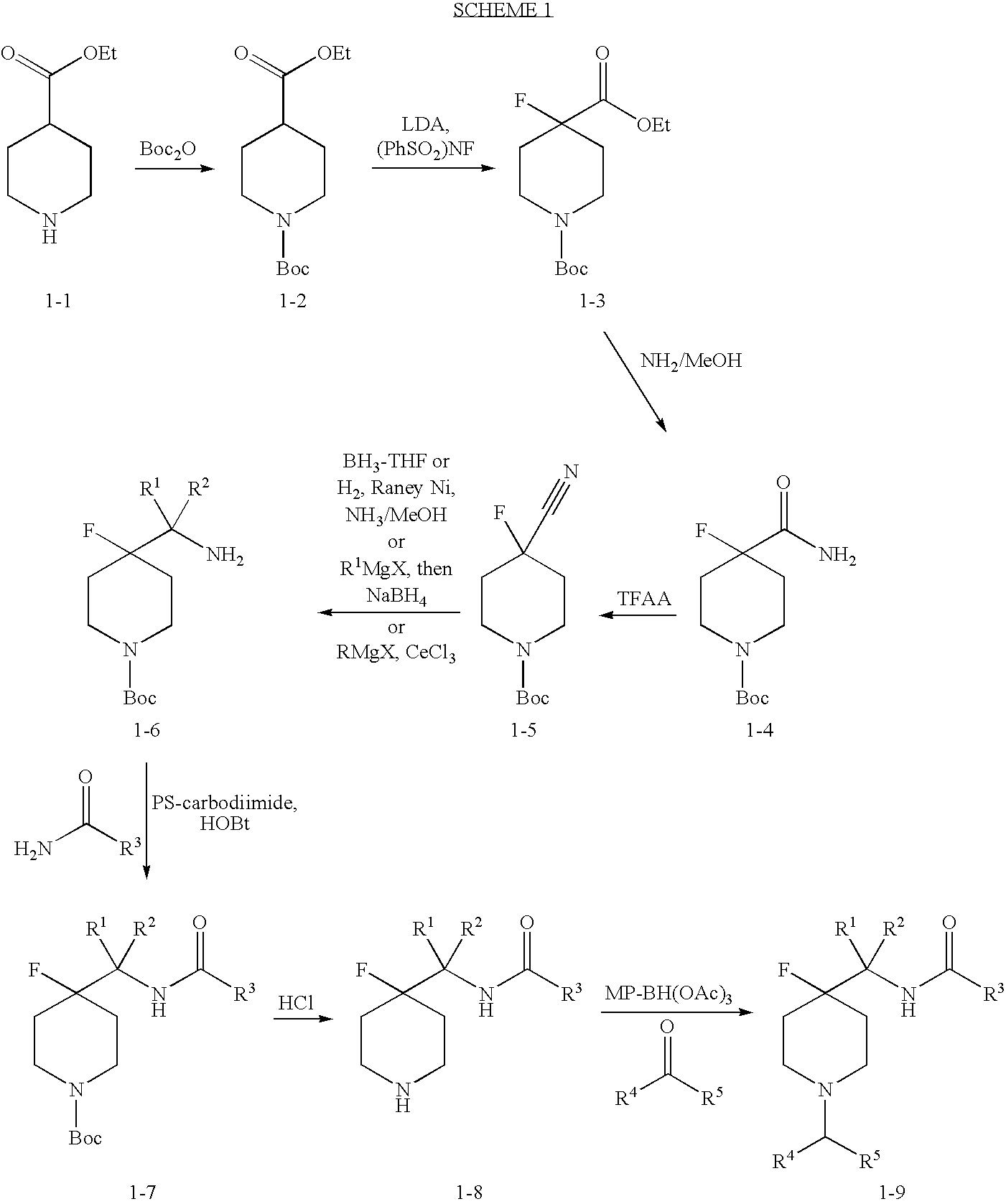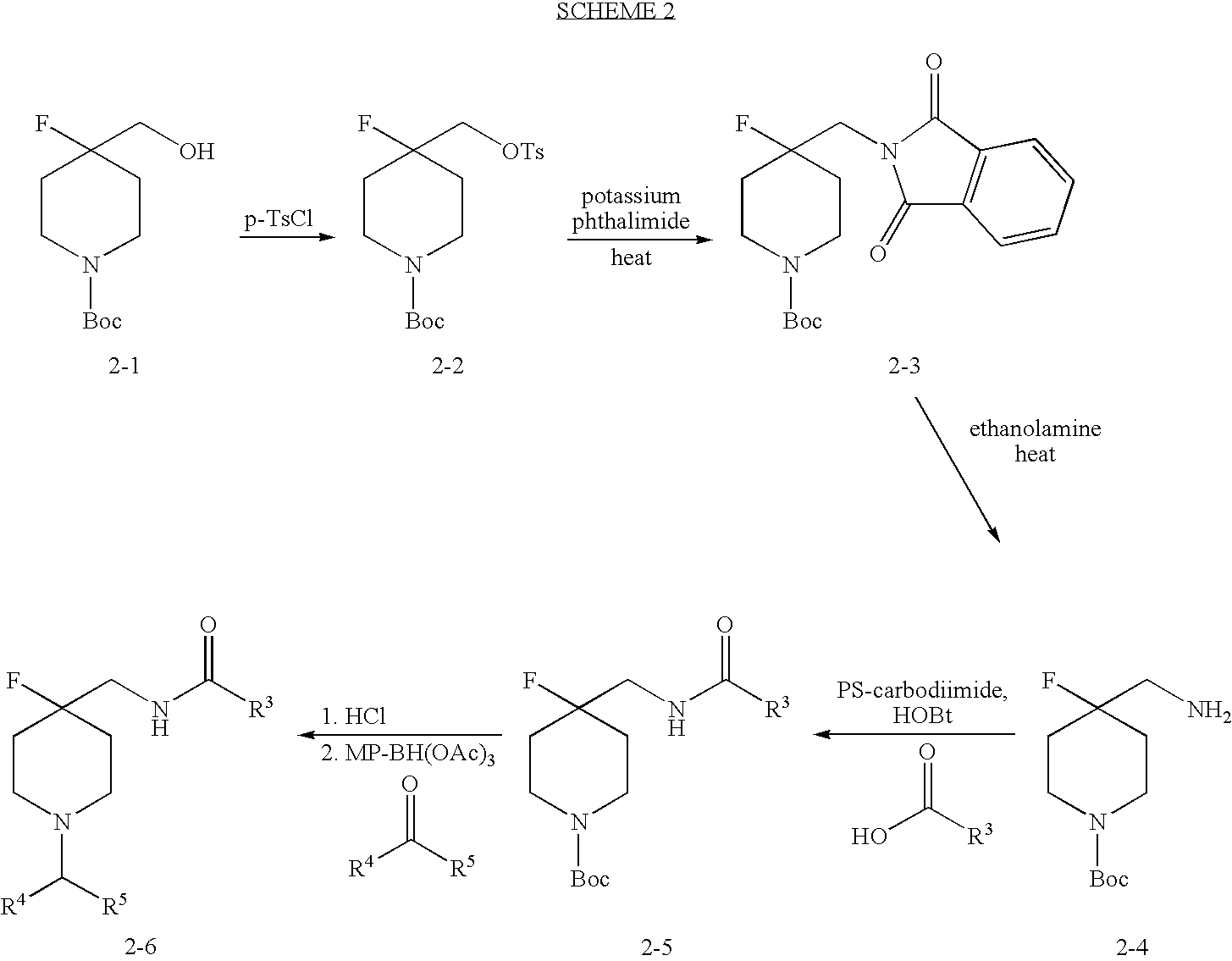4-Fluoro-Piperidine T-Type Calcium Channel Antagonists
a fluoro-piperidine and calcium channel technology, applied in the field of voltage gated channel proteins, can solve the problems of numerous problems in the known therapeutic regimen for such treating such diseases and disorders
- Summary
- Abstract
- Description
- Claims
- Application Information
AI Technical Summary
Benefits of technology
Problems solved by technology
Method used
Image
Examples
example 1
[0192]
tert-butyl 4-fluoro-4-((tosyloxy)methyl)piperidine-1-carboxylate (3-2)
[0193]To a 0° C. mixture of 3-1 (4.55 g, 19.5 mmol) in 20 mL pyridine was added p-toluenesulfonyl chloride (4.09 g, 21.5 mmol). After the addition, the reaction was allowed to warm to ambient temperature and stir for 4 h. The reaction was then poured into H2O (100 mL) and extracted with CH2Cl2 (3×100 mL). The combined organic layers were washed with brine (150 mL), dried over MgSO4, filtered, and concentrated in vacuo. Residual pyridine was azeotropically removed with heptane (4×), giving 6.78 g (90%) of a peach-orange oil. 1H NMR (CDCl3, 300 MHz): 7.77 (d, J=8.4 Hz, 2H), 7.34 (d, J=8.4 Hz, 2H), 3.91 (br, 2H), 3.01 (m, 2H), 2.42 (s, 3H), 1.79 (m, 2H), 1.53 (m, 4H), 1.43 (s, 9H); MS (Electrospray): m / z 333.1 (M−t−Bu+H).
tert-butyl 4-((1,3-dioxoisoindolin-2-yl)methyl)-4-fluoropiperidine-1-carboxylate (3-3)
[0194]To a solution of 3-2 (6.78 g, 17.5 mmol) in 70 mL DMF was added potassium phthalimide (4.21 g, 22.7 m...
example 2
[0198]
tert-butyl 4-carbamoyl-4-fluoropiperidine-1-carboxylate (4-2)
[0199]Commercially available ester 4-1 (0.275 g, 1.0 mmol) was treated with a 2 M solution of NH3 in MeOH. The mixture was allowed to stir for 24 h at room temperature. All solvent was removed in vacuo. The crude amide 4-2 was carried forward. 1H NMR (CDCl3, 300 MHz): 6.44 (br, 2H), 4.01 (br, 2H), 2.98 (br, 2H), 2.05 (m, 2H), 1.77 (m, 2H), 1.41 (s, 9H); MS (Electrospray): m / z 232.1 (M−Me+H), 191.1 (M−t−Bu+H).
tert-butyl-4-cyano-4-fluoropiperidine-1-carboxylate (4-3)
[0200]To a solution of 4-2 (0.246 g crude, 1.0 mmol) in 1 mL pyridine and 1 mL dry CH2Cl2 was added trifluoroacetic anhydride (0.525 g, 0.35 mL, 2.5 mmol). After 20 min, all solvent was removed in vacuo employing an n-heptane azeotrope (3×) to remove all traces of pyridine. The residue was partitioned between Et2O and H2O, washed with saturated aq. NaHCO3, dried over MgSO4, filtered, and concentrated in vacuo, giving 0.280 g of crude material as a yellow-or...
example 3
[0204]
3-chloro-N-{[1-(3,3-dimethyl-2-oxobutyl)-4-fluoropiperidin-4-yl]methyl}-5-methoxybenzamide
[0205]To a solution of benzyl 4-(aminomethyl)-4-fluoro-piperidine-1-carboxylate (Claiborne, C. F.; Butcher, J. W. Claremon, D. A.; Libby, B. E.; Claremon, D. A.; Liverton, N.J.; Munson, P. M.; Nguyen, K. T.; Phillips, B.; Thompson, W.; McCauley, J. A., PCT Int. Appl WO2002068409 (2002)) (2.2 g, 8.1 mmol) in CH2Cl2 (20 mL) at room temperature was added 3-chloro-5-methoxylbenzoyl acid (1.7 g, 9.0 mmol), HOAt (1.3 g, 9.8 mmol) and EDC (1.9 g, 9.8 mmol). The resulting mixture was allowed to stir at room temperature for 2 h. LC-MS indicated that the reaction was completed. The reaction mixture was diluted with water (20 mL) and the two layers were separated. The aqueous layer was extracted with CH2Cl2 twice (20 mL each). The combined organic layers were dried (Na2SO4), filtered and the filtrated was concentrated. The crude residue was dissolved in CH2Cl2 (10 mL), and to this mixture was then a...
PUM
| Property | Measurement | Unit |
|---|---|---|
| Volume | aaaaa | aaaaa |
Abstract
Description
Claims
Application Information
 Login to View More
Login to View More - R&D
- Intellectual Property
- Life Sciences
- Materials
- Tech Scout
- Unparalleled Data Quality
- Higher Quality Content
- 60% Fewer Hallucinations
Browse by: Latest US Patents, China's latest patents, Technical Efficacy Thesaurus, Application Domain, Technology Topic, Popular Technical Reports.
© 2025 PatSnap. All rights reserved.Legal|Privacy policy|Modern Slavery Act Transparency Statement|Sitemap|About US| Contact US: help@patsnap.com



